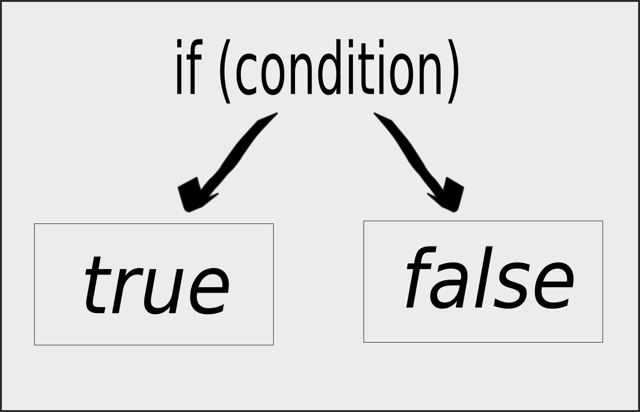
選擇結構有單一選擇跟多重選擇,兩者都使用 if 陳述 (if statement) , if 為關鍵字 (keyword) 之一,若是多重選擇 if 須與 elsif 或 else 連用。單一選擇,也就是單獨使用 if 陳述如下
if (3 < 5) { print "Oh! 3 is bigger than 5!\n";} |
條件為 if 後面的小括弧,上例為 3 大於 5 ,如果 3 大於 5 為真,程式就會執行條件後大括弧中的程式區塊 (block) 。如果 3 大於 5 為假,程式自然跳過條件後的程式區塊,去找區塊後的第一個陳述 (statement) 執行。
if 與 else 連用,條件為真,執行 if 後的程式區塊,條件為假,就執行 else 後的程式區塊
if (3 < 5) { print "Oh! 3 is bigger than 5!\n";}else { print "Not Bad! 3 is not bigger than 5!\n";} |
elsif 表示其他的條件,形成 if-elsif-else 的多重選擇,最後的 else 表示以上皆非
if (3 < 5) { print "Oh! 3 is bigger than 5!\n";}elsif (4 > 5) { print "Oh! 4 is bigger than 5!\n";}elsif (5 > 5) { print "Oh! 5 is bigger than 5!\n";}elsif (6 > 5) { print "Of course, 6 is bigger than 5!\n";}else { print "There is no case :(\n";} |
我們將以上寫成完整的範例程式,如下
1 2 3 4 5 6 7 8 9 10 11 12 13 14 15 16 17 18 19 20 21 22 23 24 25 26 | #!/usr/bin/env perlprint "\n";if (3 > 5) { print "Oh! 3 is bigger than 5!\n";}elsif (4 > 5) { print "Oh! 4 is bigger than 5!\n";}elsif (5 > 5) { print "Oh! 5 is bigger than 5!\n";}elsif (6 > 5) { print "Of course, 6 is bigger than 5!\n";}else { print "There is no case :(\n";}print "\n";# 《程式語言教學誌》的範例程式# 檔名:selection.pl# 功能:示範 Perl 程式# 作者:張凱慶# 時間:西元 2013 年 1 月 |
執行結果如下

另舉一例如下
1 2 3 4 5 6 7 8 9 10 11 12 13 14 15 16 17 18 19 20 21 22 23 24 25 26 27 | #!/usr/bin/env perlprint "\n";$s = 6;if ($s == 3) { print "3...\n";}elsif ($s == 4) { print "4...\n";}elsif ($s == 5) { print "5...\n";}elsif ($s == 6) { print "6...\n";}else { print "There is no case :(\n";}print "\n";# 《程式語言教學誌》的範例程式# 檔名:selection2.pl# 功能:示範 Perl 程式# 作者:張凱慶# 時間:西元 2013 年 1 月 |
這裡的條件為判斷某一變數 (variable) 是否符合某一常數 (constant) ,執行結果如下

複合陳述 (compound statement) 除了選擇結構 (selection structure) 還有重複結構 (repetition structure) ,重複結構也被稱為迴圈 (loop) ,接下來我們就來看看如何使用迴圈吧!
| 中英文術語對照 | |
|---|---|
| 選擇 | selection |
| 條件 | condition |
| if 陳述 | if statement |
| 關鍵字 | keyword |
| 程式區塊 | block |
| 陳述 | statement |
| 常數 | constant |
| 變數 | variable |
| 複合陳述 | compound statement |
| 選擇結構 | selection structure |
| 重複結構 | repetition structure |
| 迴圈 | loop |
您可以繼續參考
基礎篇
相關目錄
回 Perl 入門指南
回 Perl 教材
回首頁
參考資料
http://perldoc.perl.org/perlintro.html
http://perldoc.perl.org/perlsyn.html
http://www.tutorialspoint.com/perl/perl_conditions.htm
沒有留言:
張貼留言